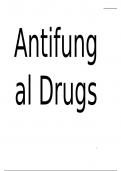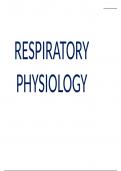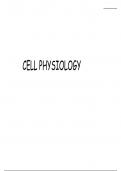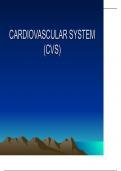STUDY NOTES HUB
Study notes hub is a centralized platform where students can access a wide variety of educational resources to help them learn and succeed in their academic pursuits. The hub typically contains study notes, summaries, flashcards, and other useful materials, all organized to make it easy for students to find what they need.
- 18
- 0
- 0
Community
- Followers
- Following
18 items

Respiratory system Anatomy
The document describes the respiratory anatomy which comprises a network of specialized structures that enable the exchange of gases essential for life.
- Class notes
- • 7 pages •
The document describes the respiratory anatomy which comprises a network of specialized structures that enable the exchange of gases essential for life.

Respiratory Pathology Essentials: Your Ultimate Study Companion for Academic Achievement
Respiratory physiology is the intricate process by which our bodies exchange gases to support cellular function. Inhalation begins as the diaphragm contracts, expanding the thoracic cavity and lowering air pressure, allowing air to rush into the lungs.
- Presentation
- • 19 pages •
Respiratory physiology is the intricate process by which our bodies exchange gases to support cellular function. Inhalation begins as the diaphragm contracts, expanding the thoracic cavity and lowering air pressure, allowing air to rush into the lungs.

Essential Anti fungal Notes for Academic Excellence.
This document contains the drugs that treat various Specific fungous infections in the body
- Summary
- • 66 pages •
This document contains the drugs that treat various Specific fungous infections in the body

RESPIRATORY PHYSIOLOGY
Respiratory physiology governs gas exchange vital for life. Air enters the body through the nose and mouth, and travels to the lungs, where oxygen is absorbed and carbon dioxide expelled in tiny air sacs called alveoli. This process, facilitated by the diaphragm and respiratory muscles, ensures tissues receive oxygen and waste is removed. Brainstem regulation fine-tunes breathing based on metabolic needs.
- Class notes
- • 250 pages •
Respiratory physiology governs gas exchange vital for life. Air enters the body through the nose and mouth, and travels to the lungs, where oxygen is absorbed and carbon dioxide expelled in tiny air sacs called alveoli. This process, facilitated by the diaphragm and respiratory muscles, ensures tissues receive oxygen and waste is removed. Brainstem regulation fine-tunes breathing based on metabolic needs.

CELL PHYSIOLOGY
Cell physiology is the branch of biology that explores the functions and activities of cells, the fundamental units of life. It delves into how cells perform essential processes such as metabolism, growth, division, and response to stimuli. This field examines various aspects of cellular function, including the transport of molecules across cell membranes, energy production through processes like cellular respiration and photosynthesis, communication between cells, and the maintenance of interna...
- Essay
- • 52 pages •
Cell physiology is the branch of biology that explores the functions and activities of cells, the fundamental units of life. It delves into how cells perform essential processes such as metabolism, growth, division, and response to stimuli. This field examines various aspects of cellular function, including the transport of molecules across cell membranes, energy production through processes like cellular respiration and photosynthesis, communication between cells, and the maintenance of interna...

Anatomy and Physiology of the Cardiovascular System
The cardiovascular system, comprising the heart and blood vessels, is responsible for circulating blood throughout the body. The heart pumps oxygen-rich blood from the lungs to the body's tissues via arteries, while veins return oxygen-depleted blood to the heart for reoxygenation. This system ensures the delivery of nutrients, oxygen, and hormones to cells, as well as the removal of metabolic waste products. The heart's rhythmic contractions, controlled by electrical impulses, maintain blood ...
- Class notes
- • 19 pages •
The cardiovascular system, comprising the heart and blood vessels, is responsible for circulating blood throughout the body. The heart pumps oxygen-rich blood from the lungs to the body's tissues via arteries, while veins return oxygen-depleted blood to the heart for reoxygenation. This system ensures the delivery of nutrients, oxygen, and hormones to cells, as well as the removal of metabolic waste products. The heart's rhythmic contractions, controlled by electrical impulses, maintain blood ...

Blood Basics: Your Essential Guide to Understanding Body Fluids.
Certainly: "Blood is a vital bodily fluid that circulates through the arteries and veins, delivering oxygen and nutrients to cells while removing waste products. Comprising plasma, red blood cells, white blood cells, and platelets, blood plays essential roles in oxygen transport, immune defense, and clotting. Its red color comes from hemoglobin, a protein that binds oxygen. Blood tests are commonly used in medical diagnostics to assess overall health, detect diseases, and monitor treatment ef...
- Presentation
- • 48 pages •
Certainly: "Blood is a vital bodily fluid that circulates through the arteries and veins, delivering oxygen and nutrients to cells while removing waste products. Comprising plasma, red blood cells, white blood cells, and platelets, blood plays essential roles in oxygen transport, immune defense, and clotting. Its red color comes from hemoglobin, a protein that binds oxygen. Blood tests are commonly used in medical diagnostics to assess overall health, detect diseases, and monitor treatment ef...

nervous system examinable questions
Nervous system questions
- Exam (elaborations)
- • 10 pages •
Nervous system questions
